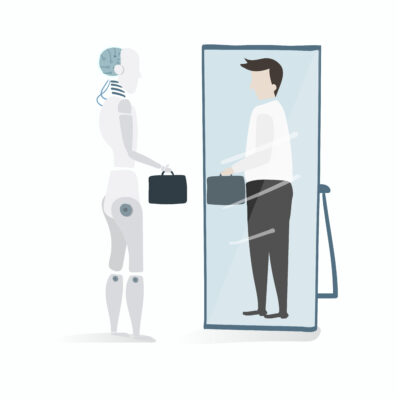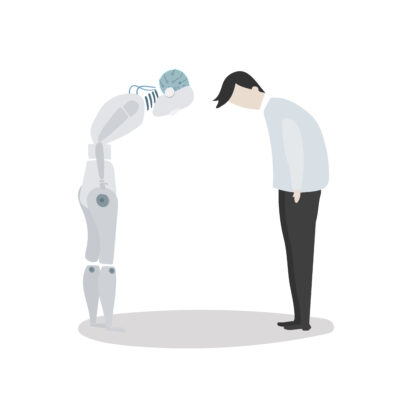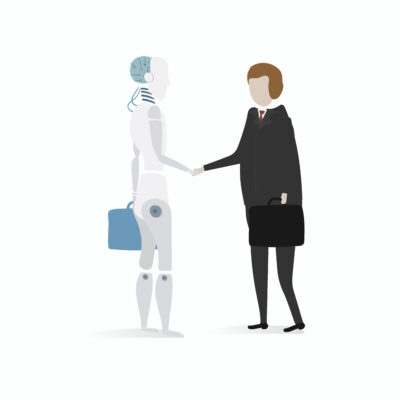Ever since ChatGPT publicly debuted in November 2022, the world has been captivated by the potential for artificial intelligence (AI) to radically transform nearly every aspect of life and culture, for better or worse.
Congressional hearings, academic conferences, corporate boardrooms, and social media networks have erupted into lively debates over the benefits and risks of AI, with experts (and plenty of non-experts) calling for the complete expulsion of AI from society, a wholehearted embrace, and everything in between.
For many human resources professionals, however, the debate is nothing new. Some HR teams have been using AI tools to streamline time-consuming tasks, gain data-driven insights, and engage employees for several years. ChatGPT and other tools like it (chatbots designed to mimic human conversation, generate coherent text in various styles, and answer questions) are simply the latest examples of AI’s disruptive capacity.
According to a 2022 survey of 259 HR leaders, the majority of HR teams have used AI to some extent for:
- Employee records management
- Payroll processing and benefits administration
- Recruitment and hiring
- Performance management
- Onboarding new employees
However, the latest generation of AI tools — led by ChatGPT and its imitators — point toward a future where AI is enormously more powerful and its results more indistinguishably human. For the department most explicitly dedicated to serving, enabling, and championing an organization’s “human resources,” this can raise some concerns.
There are essentially three approaches HR teams can take toward the increased adoption of AI within their organization, embodied by the following archetypes:

Archetype 1: The Full Embracer
Some HR teams will take a full-steam-ahead approach to AI, embracing its potential to solve nearly every problem in the organization while seeing few drawbacks. If they aren’t already, the HR department of the extremely near future might use AI to:
- Screen job candidates, analyzing and comparing skills and experience exponentially faster than humans can.
- Assess first-round job interviews.
- Expedite onboarding and training, identifying skills gaps, designing personalized training programs, and answering new-hire questions using conversational chatbots.
- Track productivity and engagement by identifying subtle shifts in employee behavior and communication.
- Guide employee decision-making regarding benefits, time off, and other HR issues using AI chatbots and cognitive engines.
- Compose educational or informational content, such as emails, offer letters, newsletters, web or intranet pages, video scripts, PowerPoint presentations and more.
The downside: AI has immense promise for helping HR teams become more efficient and effective while supporting employee success and well-being. However, it’s not yet clear if AI is entirely up to the task — at least not without significant human intervention.
Legitimate questions persist about AI bias in hiring, which is one reason 71% of Americans oppose using AI in final hiring decisions.
In general, employees view AI with a mix of skepticism and reserved optimism. Many employees may welcome the help of AI chatbots when choosing benefits or performing other arduous administrative tasks, for example. But an overreliance on AI throughout the employee experience might feel alienating.
Another open question about AI is how much it can be relied on to provide accurate information. ChatGPT’s inaccuracies are well documented, and Google’s Bard famously committed a factual error during its first public demonstration. For now, HR teams must monitor their AI tools closely, perform quality control, and fact-check to prevent the accidental spread of misinformation and ensure there are no issues with legal and compliance.

Archetype 2: The Avoider
It may already be impossible to avoid AI altogether. Still, some companies will go to extraordinary lengths to limit the use of AI within their organizations until the technology has been fully vetted.
For example, several large employers, including Amazon, Goldman Sachs, and Verizon, have restricted employee use of ChatGPT due to security concerns.
HR teams may lead efforts to limit the use of AI to reduce risk to the organization and prioritize the contributions of human employees. Some organizations are already going as far as blocking known AI chatbot domains on work computers.
There are benefits to this approach: fewer concerns such as data security and copyright issues, as well as protecting your brand from the harm that would come from lower-quality or lower-accuracy deliverables.
The downside: As noted above, there are significant business benefits to using AI, and companies that turn their back on the technology may find themselves at competitive disadvantages in the marketplace and the war for talent. This approach to AI may expose organizations to several risks:
- Reduced efficiency. Organizations that choose not to use AI and chatbots may struggle to match their competitor’s efficiency and cost-effectiveness.
- Hindered growth and scalability. Without AI tools to streamline repetitive tasks, HR teams may have difficulty scaling their services and maintaining consistent employee satisfaction and engagement levels as the company grows.
- Limited talent-acquisition capabilities. By banning AI for screening, identifying potential talent, and gaining insights on attracting suitable candidates, HR teams may miss out on top talent and experience prolonged hiring processes.
- Ineffective data analysis and decision-making. AI’s deep analytical capabilities can help HR teams identify performance, retention, and development trends and make critical decisions affecting the organization’s health. Without AI tools, HR teams may be left guessing.
- Lower employee satisfaction and engagement. AI-driven HR tools can personalize employee experiences, help promote a more inclusive culture, and foster a better understanding of employee needs through sentiment analysis. Companies that avoid these technologies may face higher attrition rates and lower employee satisfaction.
And the biggest risk: your employees will likely find ways to use it anyway. But if you ignore AI in your organization, your employees won’t understand the dos and don’ts of using AI within your organization, nor will they have guardrails to follow. As a result, they may commit some costly AI mistakes that harm your reputation or customer relationships.
Which brings us to our final archetype:

Archetype 3: The Pragmatist
Many, if not most, HR teams will neither completely reject AI nor embrace it outright. Instead, they will favor a pragmatic approach, recognizing its many benefits while proceeding with caution to mitigate its risks. This practical philosophy sees AI as a tool — a possibly revolutionary tool, but a tool, nonetheless. And like any powerful tool, AI must be used responsibly and strategically.
The focus of this approach to AI is education.
For a smooth and successful integration of AI into HR practices, teams must prioritize employee understanding and trust in the technology. This can be achieved through transparent communication and a frank, workplace-wide discussion that addresses concerns about job displacement.
Company policy on when and how to use AI should be documented, easily accessible and kept up to date with the evolving technology. Training on the proper use of AI should be standard, ensuring employees are aware of potential pitfalls and safe practices. And HR team members should continually develop their own skills to achieve the proper balance between technology and human expertise.
Your Team’s Approach to AI? Choose Carefully
Artificial intelligence technology is growing by leaps and bounds, with new AI-powered tools emerging at an unprecedented pace. How your HR team responds (along with the rest of your organization) is among the most critical decisions you’ll make in the current era.
Forging ahead haphazardly is risky, but so is ignoring the many potential benefits of AI. By adopting AI thoughtfully and strategically, HR teams can not only streamline their operations but also enhance the overall employee experience, contributing to a more dynamic and future-ready organization.







